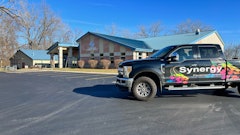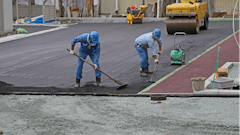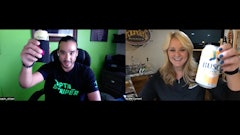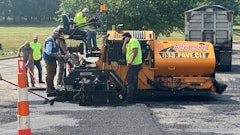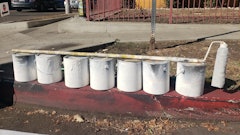
Contractors are diversifying services to become a one-stop shop for their customers, which isn't new, this has been happening for many years. If you are already performing paint striping services on parking lots or municipal work, the natural next step would be to include thermoplastic offerings to reach a broader customer base looking for a more durable, longer-lasting marking.
Thermoplastic markings, when applied to pavement, is a molten material created from melting either plastic granules or a pre-mixed material that is heated, cooled and formed into a block or powder which is then melted before application. The material is heated to 400°F - 425°F before it is applied to the pavement by a walk-behind handliner.
"It's one of those things that everything has to be lined up correctly," said Josh Ross Schnelting, Striping Manager for Alpha Paving. "The pavement needs to be at a certain temperature which typically you want to see at 50 degrees and rising. Your material needs to be a certain temperature otherwise, it comes out and big clumps. It looks like cake batter."
The learning curve with thermoplastic is fairly easy, especially if the contractor is already in the pavement marking segment. The material must reach the proper heat before application. Also, contractors should consider the surface temperature of the pavement. Applying thermoplastics at proper application temperature 400°F+ is one of the most critical factors affecting the bond to the pavement. If the road temperature is too cold, the material may fail and not adhere properly.
These lines can be thicker than a paint line, increasing the likelihood of removal by snow plows when the blade comes in contact with the thermoplastic marking, thus thermoplastic tends to be used more in warmer environments. However, there has been advancements to feather the line's leading edge making the technology more attractive in colder climates.
Equipment
Thermoplastic markings require specialized equipment to heat and hold the hot material before being placed on pavement which can be applied by handwork or long line applications.
Walk-behind handliners are small, portable pieces of equipment that hold the molten material and maintain it at the proper Thermoplastic pavement markings are used as paint, also known as hot melt marking paint.Alpha Paving | Facebook
Thermoplastic pavement markings are used as paint, also known as hot melt marking paint.Alpha Paving | Facebook
Walk-behind handliners can weigh between 275 and 300 pounds, manufacturers suggest testing them out before buying. Also, set up a test drive for any long line or ride on stripers to understand what the machines capability.
For contractors doing mostly intersections, parking lots or smaller jobs, a handliner will be the equipment choice. Handliners are preferred for jobs requiring detail work where a larger, long line trucks will not be mobile enough to achieve the desired details.
Pre-melting kettles are essential as well. The kettle is used to heat the thermoplastic material to the required temperature before application. Some trucks or ride on stripers have an integrated pre-melting kettle.
Keep the die system, the container the thermoplastic material flows through to reach the pavement surface, in mind as well. Different sizes of dies are available depending on the mil thickness of the material being applied. Know which size you'll need so you're not purchasing more than necessary or the wrong size.
Just like equipment maintenance on other equipment, thermoplastic machines need to have scheduled maintenance intervals as well. Draining the kettle daily, remove excesses material from the die and checking the burners should be done on a regular, if not daily basis.
Safety First and Foremost
Just like any other service, training and safety measures for crew members are important. Especially when working with dangerously hot materials and equipment in thermoplastic applications.
- Operators should wear proper clothing; long-sleeve shirts, long pants, hard-soled shoes, hat, heat-resistant gloves. When adding or transfering the material to the kettle, a face shield and protective apron will protect workers from any splash back that may occur.
- Keep a fire extinguisher readily available and train all crew members on its proper use.
- Have a first aid kit near, and know who to treat burns.
- Add small amounts of material at regular intervals. Try not to drop an entire bag or block into hot material already in the kettle. Doing so will cause the molten material to splash up and in some cases out.
- Try not to leave kettle or application unattended when lit.
- Do not leave burners on when the kettle is empty.
- Don't overheat material, overheating can cause fumes to ignite and cost more because the product can become scorched and unusable.
- Operators need to understand the operation of the equipment before attempting to perform any striping or maintenance. Read the operator's manual fully and familiarize yourself with the thermoplastic equipment and striping process.
Before diving into thermoplastic application make sure you and your crew are well educated on the product and the market. It is Thermoplastic paint dries quickly and can be walked on or drinen on shortly after application.Graco
Thermoplastic paint dries quickly and can be walked on or drinen on shortly after application.Graco
"Anyone that wants to get into it has to be patient," said Schnelting. "If you have no experience, it will take a little research and due diligence to try to find your best price. But once you've figured out how long it takes to do a job and the temperature factors that go along with thermoplastic, it will become natural and you can successfully complete jobs you might have previously sub contracted out."















